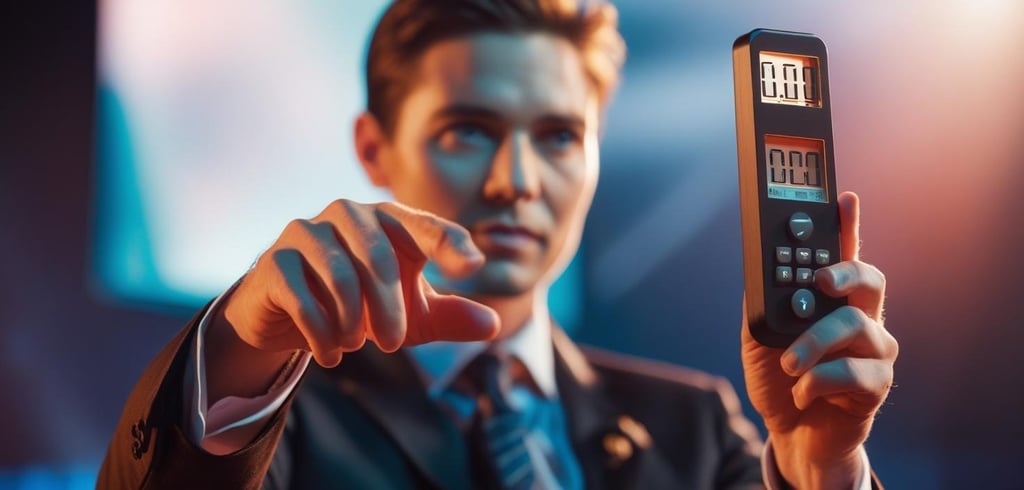Start sending invites for free - no card required - Click here
Mastering Event Pacing: Avoid Session Overruns with Countdown Timers
Event schedules are carefully crafted, but in the heat of execution, they often fall apart. One of the biggest culprits? Session overruns — those moments when a presentation or panel runs beyond its allotted time, causing a ripple effect across the entire agenda.
BLOGS
6/13/20252 min read


Event schedules are carefully crafted, but in the heat of execution, they often fall apart. One of the biggest culprits? Session overruns — those moments when a presentation or panel runs beyond its allotted time, causing a ripple effect across the entire agenda.
Organizers around the world are now relying on one simple yet powerful tool: the countdown timer for sessions.
Why Session Overruns Are a Big Problem
Overruns may seem harmless at first, but they impact more than just time:
Delayed transitions lead to attendee drop-offs
Sponsors may lose their dedicated slots
Venue contracts may be affected
Attendee satisfaction goes down
Speakers may get cut short or rushed
In a competitive landscape of live, hybrid, and virtual events — pacing is critical.
Enter the Countdown Timer
Whether it’s a session countdown timer, a countdown timer for speakers, or a stage timer for events, these tools are designed to act as your event’s silent conductor — guiding each speaker, session, and transition without disrupting flow.
What a Timer Does:
Tracks time visually and clearly
Sends cues to wrap up
Helps avoid awkward moderator interruptions
Assists backstage coordination
Types of Countdown Timers and Their Use
Countdown Timer for Sessions
Ideal for maintaining overall track timing and ensuring each slot starts and ends on time.Countdown Timer for Speakers
Best for individual speaker control, often placed on podiums or comfort monitors.Stage Timer for Conference
Helps the production team coordinate visual cues, lighting, and speaker changes.Countdown Timer for Events
Used at the macro level for starting, breaking, or concluding events on time.Timer for Presentation
Used especially in pitch sessions, classroom formats, or investor meetings.
How to Make It Work
Test Your Timer Setup
Don’t wait for show day. Set timers during dry runs and speaker rehearsals.Keep it Visible
Whether it’s a virtual overlay or a physical clock, make sure it's visible without being distracting.Color Code the Warnings
Green: Good time
Yellow: Wrap it up soon
Red: Time’s upUse for Breaks and Networking Slots
Timers aren’t just for speakers — they also help regulate breaks, sponsor exhibits, and social mingles.
Virtual vs. In-Person Considerations
In-person events benefit from physical timers and stage signals. Virtual events require:
On-screen digital timers
Audio cues for session wrap-up
Host moderation to enforce timing
A hybrid format needs both, managed in sync.
Why This Matters for Attendees
Attendees appreciate events that respect their time. A session that runs over often leads to skipped panels or early exits. A tightly timed schedule helps attendees plan, switch sessions, and stay engaged throughout.
Good time management equals a better event experience.
Final Tips for Success
Brief your speakers on timer expectations
Build buffer time into your agenda
Use countdowns creatively (gamified talks, pitch-offs, speed networking)
Ensure backup timing systems are ready
Conclusion
A countdown timer for events is a must-have for modern event production. It's an essential tool for delivering structured, professional, and timely experiences. Whether you’re managing a stage timer for a conference or setting up a timer for a presentation, incorporating countdowns into your event flow can be the difference between chaos and consistency.
BulkCalendar.in
Send Bulk & Mass Calendar Invites Instantly
Contact us
Engagement
sales@letscalendar.com
+44 (0) 203 916 5117
© 2025. All rights reserved.
Help?
